Chow Mein: A Culinary Delight Loved by Many
Chow mein, a culinary gem that has its roots in Chinese cuisine, has transcended its native boundaries to become a beloved dish globally. With its enticing combination of stir-fried noodles, savoury sauces, crisp vegetables, and a choice of protein, chow mein has captivated the palates of food lovers from all walks of life. Whether it’s served in a bustling street market in Beijing or a chic urban restaurant in New York, its appeal remains undiminished.

The burgeoning popularity of chow mein isn’t just about its delightful taste. In today’s health-conscious era, individuals are more proactive than ever about understanding what they consume. This makes the exploration of the nutritional makeup of our favourite dishes, like chow mein, not only intriguing but essential.
Dining isn’t just a sensory experience; it’s an educational one. Every bite we take tells a story of its origin, preparation, and impact on our well-being. This is particularly true for dishes that are staples in our diet. Thus, understanding the nutritional value of chow mein not only satiates our culinary curiosity but also equips us with the knowledge to make informed dining decisions.
History and Origin of Chow MeinTracing the Noodle’s Journey: From Ancient China to Global Delight
The tale of chow mein is as flavorful as the dish itself, deeply rooted in China’s rich culinary history. Noodles, a staple in Chinese cuisine, have been enjoyed for millennia, with their existence traced back to the Han Dynasty. However, the birth of what we recognize today as ‘chow mein’ is more recent, crystallizing in the vibrant streets and bustling markets of southern China.

The term “chow mein” itself is derived from the Cantonese word ‘chāu-mèing’, which translates to ‘stir-fried noodles’. Initially, chow mein was a simple stir-fry of noodles with few condiments, perhaps a reflection of the simplistic culinary preferences of the times. However, as trade routes expanded and foreign influences intermingled with Chinese culture, the dish began to evolve.
From its humble beginnings in southern China, Chow Mein travelled extensively. As Chinese immigrants moved across borders, they carried with them their culinary treasures. In every new land, chow mein was adapted to fit local palates, incorporating regional ingredients and flavours. This adaptability is what has allowed Chow Mein to transform from a local delight to a global phenomenon.
Today, whether you find yourself in a cosy eatery in London, a hip café in San Francisco, or a traditional food joint in Kuala Lumpur, chow mein has left its imprint, bearing testimony to its remarkable journey and evolution.
Basic Ingredients of Traditional Chow Mein
The Essence of Chow Mein: Unveiling Its Core Components
Chow mein, with its myriad of flavours and textures, owes its distinctiveness to a combination of simple yet impactful ingredients. Here’s a breakdown of the primary components that come together to create this iconic dish:
- Noodles: The backbone of any chow mein dish. These are typically made from wheat flour and are either soft or crispy, depending on the cooking technique.
- Protein: Choices can range from chicken, beef, shrimp, or tofu. This not only adds flavour but also provides essential nutrients to the dish.
- Vegetables: Commonly used vegetables include bell peppers, carrots, onions, and bean sprouts, adding colour, crunch, and nutrition.
- Sauce: A blend of soy sauce, oyster sauce, and sesame oil, providing the dish with its savoury, umami-rich flavour.
- Garnish: Often sprinkled with green onions, sesame seeds, or even crushed peanuts for an added layer of texture and taste.
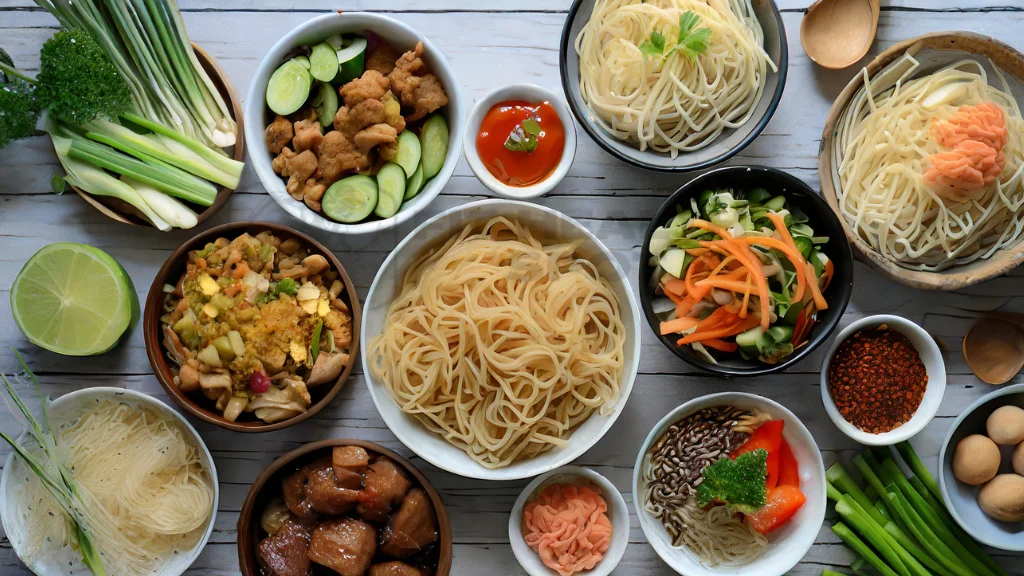
Delving Deeper: The Caloric Contributors
When examining chow men’s nutritional aspect, the primary calorie contributors are the noodles and the protein source, especially when beef or shrimp is used. The sauces, given their oil and sodium content, also play a role in the dish’s overall calorie count. Although vegetables provide some calories, they also supply vital vitamins, minerals, and fibre, which ultimately outweigh any negative aspects.
Noodles Vs. Cavatappi Pasta: A Nutritional Showdown
Noodles, the essence of chow mein, are primarily made of wheat and provide a good amount of carbohydrates. They are a quick source of energy, making them a favourite for many. On the other hand, cavatappi pasta, a spiral-shaped pasta, has recently garnered attention for its health benefits.
While both noodles and cavatappi pasta are carb-centric, cavatappi, given its shape, might have a lower Glycemic Index (GI), meaning it releases sugar more slowly into the bloodstream. This can be beneficial for those monitoring their blood sugar levels. Moreover, if one were to delve into whole-grain versions of both, one would find a higher fibre content, aiding in digestion and satiety.
For those curious about diving deeper, cavatappi pasta’s health benefits and recipes offer an insightful look into its nutritional profile and how it stands as a worthy contender in the world of staple carbohydrates.
Breaking Down the Calories
The Caloric Essence: Chow Mein Noodles
Noodles are the heart and soul of chow mein, enveloping the dish with its character and flavour. However, when considering health and nutrition, understanding the caloric content of these noodles becomes essential.
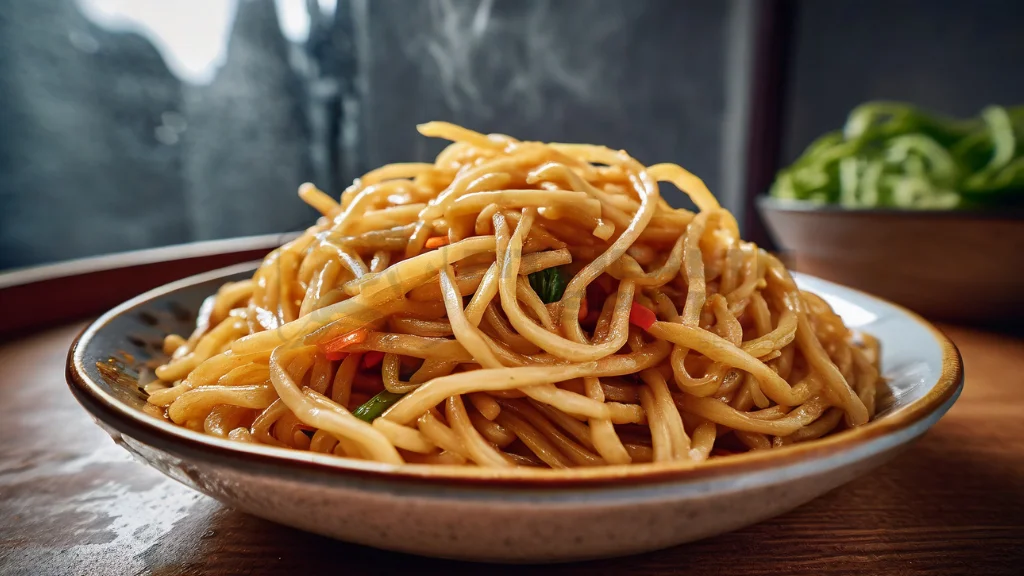
Diving into Types and Their Caloric Values
Chow mein noodles can be broadly categorized into a few types based on their ingredients and preparation:
- Wheat-based Noodles: The most common type, these noodles contain about 210-220 calories per cup, primarily from carbohydrates.
- Egg Noodles: Often richer in flavour and slightly higher in calories, these contain around 220-230 calories per cup due to the added protein from eggs.
- Whole Grain Noodles: These provide roughly 200 calories per cup but are denser in nutrients like fibre and minerals.
Each type of noodle comes with its unique nutritional profile, suiting various dietary preferences and needs.
Comparing Noodles with Healthier Alternatives
While traditional chow mein noodles are undeniably delicious, there are healthier alternatives available that offer a different set of nutritional benefits:
- Buckwheat Flour Noodles: Despite its name, buckwheat is unrelated to wheat and is free from gluten. These noodles, commonly referred to as soba, provide approximately 180 calories per cup and are abundant in essential amino acids and minerals. Discover more about the benefits of buckwheat flour here.
- Oat Bran Noodles: Made using oat bran, these noodles are lower in calories, averaging 170 per cup. They also boast a higher fibre content, which is beneficial for digestion and heart health. Dive into oat bran’s myriad health benefits here.
Incorporating alternatives like buckwheat flour or oat bran noodles into one’s diet can offer a refreshing twist on the traditional chow mein while also boosting the dish’s nutritional profile.
Protein Additions: Not Just for Taste
The Wide Array of Protein Choices
Chow mein, despite its carbohydrate-rich base, can be a source of good quality protein depending on the additions made. These protein toppings not only enhance flavor but also the nutritional value of the dish.
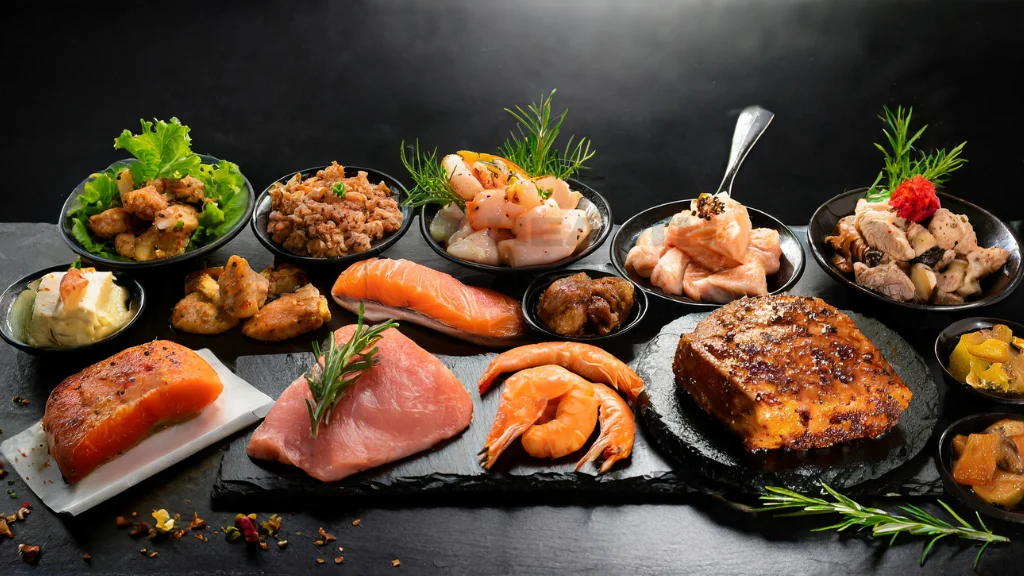
Diving Deep: Health Benefits of Smoked Salmon
While all protein sources have their merits, smoked salmon stands out due to its unique benefits:
- Omega-3 Fatty Acids: Supports heart health by reducing triglycerides.
- High-Quality Protein: Necessary for the upkeep and restoration of muscles.
- Rich in Vitamins and minerals, In particular, B vitamins, selenium, and potassium.
Smoked salmon can be an upscale and beneficial protein addition to chow mein. Learn more about smoked salmon and its health attributes here.
Understanding the Caloric Contribution
Here’s a breakdown of caloric content for common protein additions:
- Chicken: Approximately 165 calories per 100 grams.
- Beef: Roughly 250 calories per 100 grams, depending on the cut.
- Shrimp: A mere 85 calories per 100 grams.
- Smoked Salmon: About 180 calories per 100 grams, with its rich flavour and fats.
Vegetables and Add-ons: More Than Just Fillers
The Colorful World of Veggies in Chow Mein
The versatility of chow mein lies in its ability to incorporate a variety of vegetables. They not only add crunch and flavor but also a myriad of nutrients.
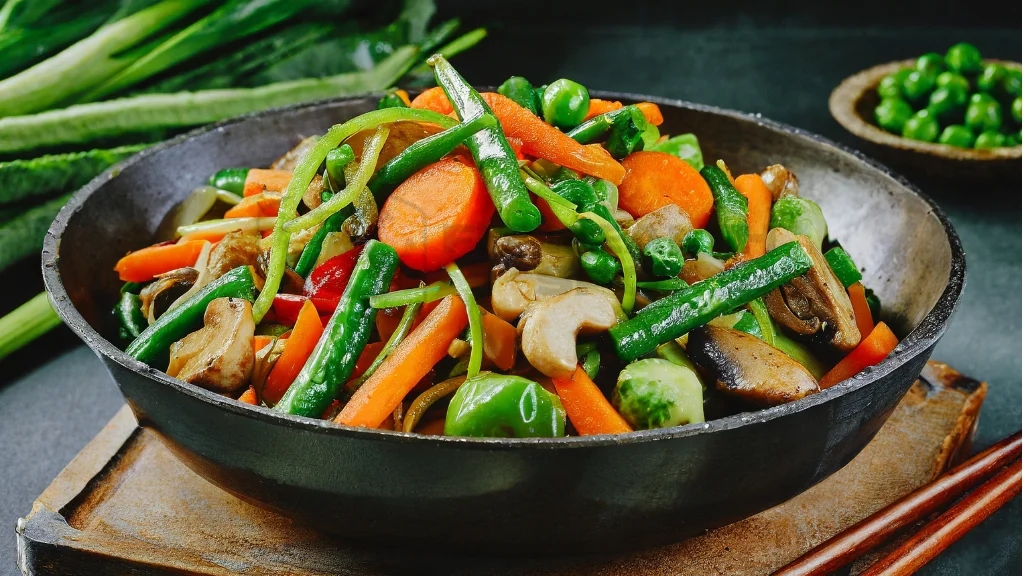
Lima Beans and Green Papaya: Beyond the Usual
While not traditional, ingredients like lima beans and green papaya can be unique additions:
- Lima Beans: A powerhouse of dietary fibre and protein, lima beans are a great way to add texture. Dive deeper into the benefits of lima beans here.
- Green Papaya: Loaded with papain, an enzyme beneficial for digestion, this can add a refreshing twist. Find out more about green papaya’s extensive health advantages here.
Navigating the Sauce Spectrum
The Role of Sauces: Flavor with a Caloric Price
Sauces play a pivotal role in defining the taste of chow mein. However, they also contribute significantly to the caloric content.
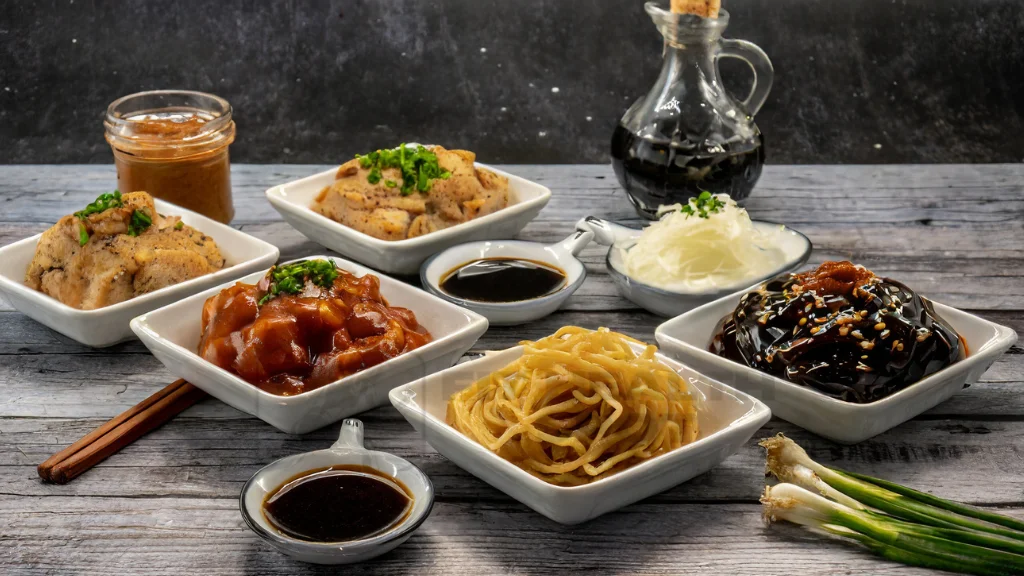
Garlic Cloves: A Healthful Addition
Incorporating garlic sauce or freshly crushed garlic cloves not only elevates flavour but also imparts health benefits:
- Natural Antioxidant: Fights oxidative stress.
- Anti-inflammatory Properties: Helps in reducing inflammation in the body.
- Boosts Immunity: A natural immune enhancer especially beneficial in cold seasons.
A proper understanding of the sauce’s implications on health can be vital. Discover more about the magic of garlic cloves and their health benefits here.
Healthy Modifications for Chow Mein Recipes
The Quest for Healthier Chow Mein
Traditional chow mein is undeniably delicious, but there’s always room for healthier modifications, especially for those mindful of their caloric and nutritional intake. By introducing innovative ingredients and substitutes, one can transform the classic dish into a guilt-free pleasure.
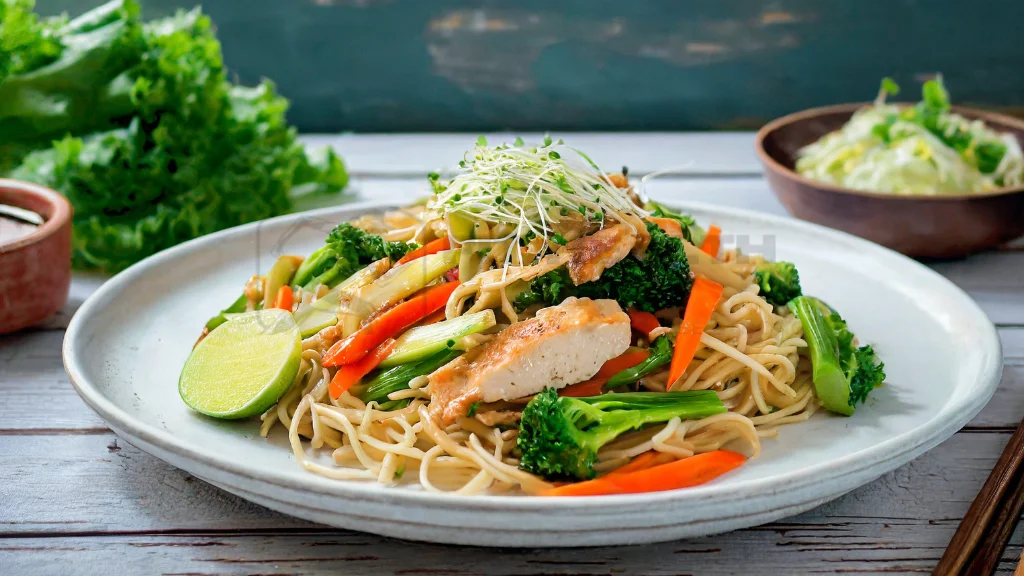
Revolutionizing Sauces: The Low-Calorie Way
The sauce often dictates the overall calorie count and flavour profile of chow mein. Switching to low-calorie alternatives can make a world of difference.
- Soy Sauce Substitute: Opt for low-sodium soy sauce or tamari to reduce salt intake.
- Oyster Sauce Alternative: A homemade blend of mushroom soy sauce, a touch of brown sugar, and vegetable broth can serve as a low-calorie substitute.
- Hoisin Sauce Replacement: A mixture of low-sodium soy sauce, peanut butter, a dash of honey, and some vinegar can mimic the taste without the added calories.
Green Olives: An Unexpected Healthy Twist
Green olives, though not traditional in chow mein, can be a source of inspiration for a unique sauce or as an innovative topping:
- Rich in Antioxidants: Olives contain vitamin E and other powerful antioxidants.
- Heart Health: The monounsaturated fats in olives are known to be heart-healthy.
- Natural Sodium: Using crushed green olives can add a salty flavour, potentially reducing the need for added salt or high-sodium sauces.

For more insights on the varied benefits and culinary uses of green olives, dive into this comprehensive guide.
Comparative Analysis: Chow Mein vs. Other Popular Dishes
Chow Mein: A Culinary and Nutritional Perspective
Chow mein, with its irresistible combination of savoury sauces, crispy noodles, and fresh vegetables, is a cherished dish worldwide. But how does it compare nutritionally to other popular dishes?
Calorie Count: Chow Mein vs. The Rest
At the core, the caloric content of chow mein primarily depends on its preparation and ingredients. However, on average:
- Chow Mein: A standard serving of chow mein has approximately 450-500 calories. This can vary based on the type and amount of protein, vegetables, and sauce used.

The Green Tea Shots Paradigm
Green tea shots, while not a direct alternative to main dishes like chow mein, serve as an interesting point of comparison:
- Calories: A standard green tea shot typically contains around 100-130 calories.
- Nutritional Benefits: Green tea shots are not only about taste; they come packed with antioxidants, particularly catechins, known to have several health benefits.
How does this relate to chow mein? Well, if you’re having a meal and considering what to pair it with, understanding the calorie and health implications of beverages can be as crucial as the main dish itself. So, while chow mein satiates your hunger, a green tea shot can be an accompanying beverage, offering both taste and health benefits.
In this comparison, chow mein stands as a fulfilling dish, both in terms of taste and satiety. While green tea shots might not serve as a main course alternative, they highlight the importance of being aware of the nutritional aspects of all parts of a meal, from the main dish to beverages.
Recipe Spotlight: Low-Calorie Chow Mein
Introduction to the Healthier Choice
Who says that indulging in your favourite dishes means piling on the calories? With a few tweaks and mindful choices, you can savour the deliciousness of chow mein without the guilt. Below is a low-calorie version of this beloved dish, ensuring taste without compromising health.
Low-Calorie Chow Mein Recipe
Ingredients:
- Whole wheat or buckwheat noodles
- Lean protein (chicken breast or tofu cubes)
- Vegetables: bell peppers, snow peas, carrots, broccoli
- Low-sodium soy sauce, freshly grated ginger, and minced garlic for the sauce
- A sprinkle of sesame seeds (optional)
Method:
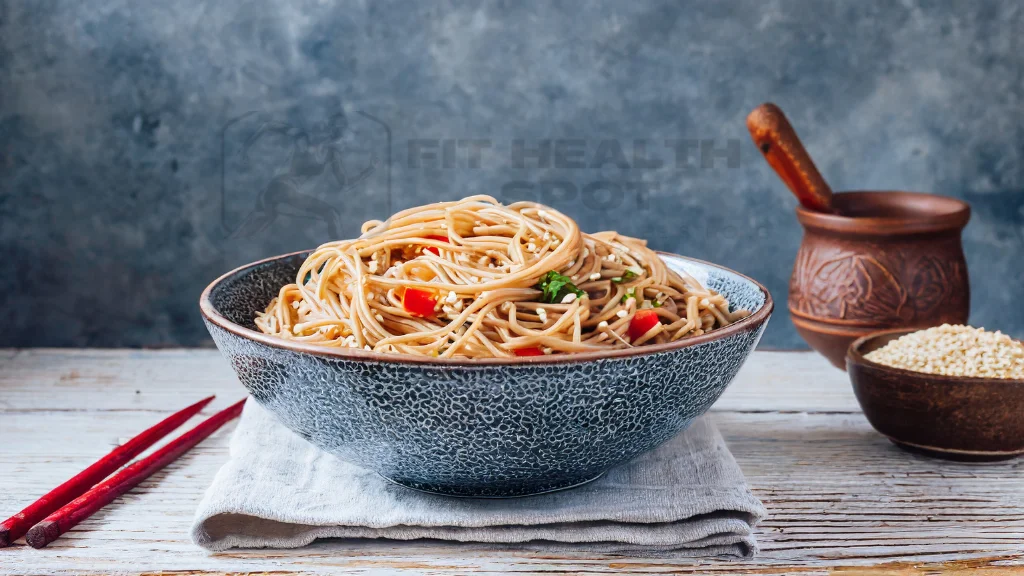
- Prepare the Noodles: Boil the whole wheat or buckwheat noodles as per the instructions on the packet. Once done, drain and set aside.
- Stir-fry the Protein: Heat a wok or pan, then drizzle some olive oil into it and sauté your preferred lean protein until it turns a golden colour and is fully cooked. Remove and set aside.
- Sauté the Veggies: In the same pan, pour a little extra oil and toss in the sliced vegetables. Stir-fry them until they are slightly tender but still have a crunch.\ Bring
- Everything Together: Add the noodles and protein back into the wok. Pour the sauce mixture (low-sodium soy sauce, ginger, and garlic) over everything and give it a good toss.
- Garnish and Serve: Once everything is well-combined and heated through, transfer to a plate and garnish with a sprinkle of sesame seeds.
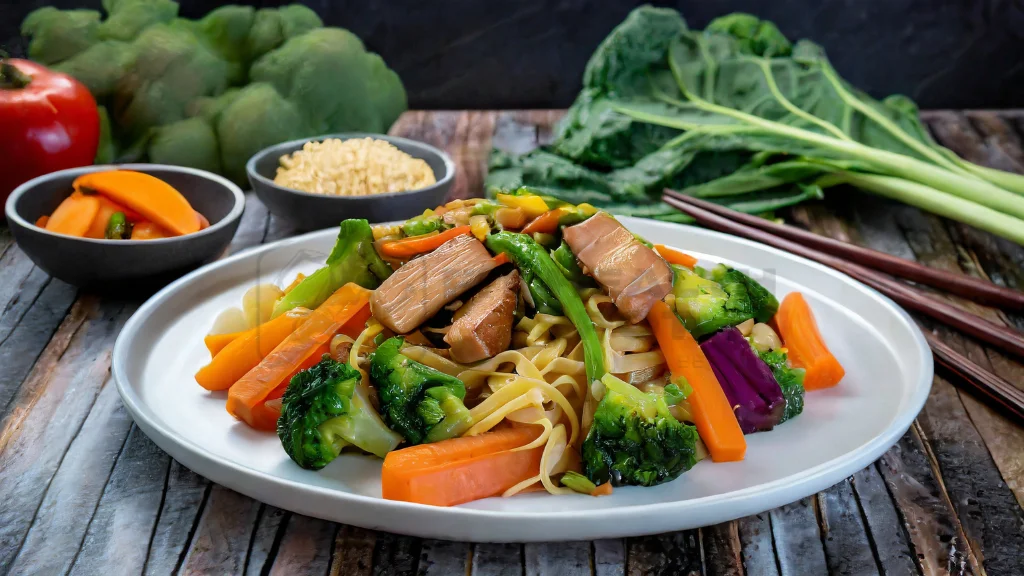
Tips for Portion Control and Mindful Eating
Portion Control: Always use a standard-sized plate to ensure you don’t over-serve. A practical suggestion is to aim for a plate that’s divided into half veggies, a quarter of protein, and the remaining quarter for noodles.
Mindful Eating: Engage all your senses while eating. Chew slowly and savour each bite. This not only enhances the dining experience but also ensures you recognize when you’re full.
Benefits of Mindful Eating and Fasting: Mindful eating can lead to reduced calorie intake and better digestion. Additionally, integrating methods like intermittent and dry fasting can provide a metabolic reset for the body and further enhance the benefits of mindful eating.
This recipe, combined with the practice of portion control and mindful eating, offers a holistic approach to enjoying a classic dish more healthily. Whether it’s a weekday dinner or a special occasion, this low-calorie chow mein can be your go-to choice without any regrets.
Conclusion
In the grand culinary journey, chow mein stands as a testament to how tradition can intertwine seamlessly with modern dietary needs. Our approach to food must evolve just as our understanding of nutrition does. The chow mein, with its rich history and adaptable nature, serves as an example. We need not sacrifice our favourite dishes; instead, with a sprinkle of creativity and a dash of mindfulness, we can strike a harmonious balance. A balance where indulgence meets health, where every bite is a celebration of flavour without being a compromise on well-being.
Frequently Asked Questions (FAQs)
What’s the main difference between chow mein and lo mein?
The primary difference lies in the preparation of the noodles. While chow mein noodles are stir-fried to achieve a crispier texture, lo mein noodles are boiled and then mixed with sauce, resulting in a softer texture.
Are there gluten-free options for chow mein noodles?
Yes, you can opt for rice noodles or buckwheat noodles as a gluten-free alternative to traditional chow mein noodles.
Is it possible to make a vegetarian or vegan version of chow mein?
Absolutely! You have the option to forgo the meat and incorporate an array of vegetables, tofu, or tempeh as your protein source.
How can I ensure my chow mein remains low in sodium?
Use low-sodium soy sauce and avoid adding any additional salt. Additionally, opt for fresh ingredients over canned ones, as canned items often contain added salt for preservation.
What are some other healthy modifications for traditional recipes?
Alongside using whole-grain noodles and lean protein, you can also incorporate more vegetables into the dish, use olive oil for stir-frying, and explore low-calorie sauce alternatives.
Exploring the world of chow mein and its numerous variations can be an exciting culinary adventure. With the right knowledge and choices, it’s entirely possible to savour this dish while staying aligned with one’s health goals. Remember, it’s all about balance, moderation, and mindful eating.
